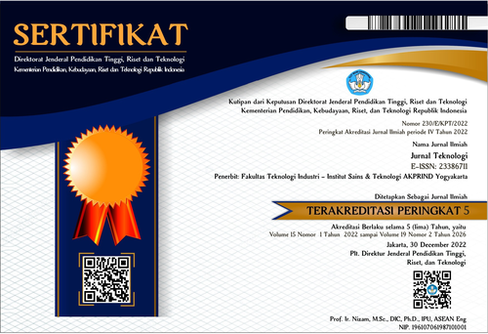Pengembangan Media Pembelajaran Pengenalan Makanan Sehat Augmented Reality Bagi Anak Sekolah Dasar Kelas 1
DOI:
https://doi.org/10.34151/jurtek.v16i2.4238Keywords:
Elementary School, learning media, Research and DevelopmentAbstract
This research was developed to overcome the problem of young children who find it very difficult to understand learning about healthy food in a monotonous way. When playing alone when the teacher gives an explanation is a sign that the child is bored with the learning activity. Early childhood children tend to obey their teachers more than their parents. This research aims to develop Augmented Reality learning media for the introduction of healthy food for grade 1 elementary school children using the Research and Development (R&D) method. The result of this development and research is an Augmented Reality Learning Media Application for Introduction to Healthy Food for grade 1 Elementary School children. The development of learning media in this research has been tested with several experts consisting of media experts, material experts and respondents. The test results from this research reached 87%, which means this application can be categorized as very suitable for use. Based on the tests that have been carried out, it can be concluded that this research and development has produced a product in the form of a learning media application for the introduction of healthy food which is very suitable for use by grade 1 Elementary School children.
Downloads
References
Apriliani, M. A., Maksum, A., Wardhani, P. A., Yuniar, S., & Setyowati, S. (2021). Pengembangan media pembelajaran PPKn SD berbasis Powtoon untuk mengembangkan karakter tanggung jawab. Jurnal Ilmiah Pendidikan Dasar, 8(2), 129-145.
Burhanudin, A. (2017). Pengembangan media pembelajaran augmented reality pada mata pelajaran dasar elektronika di smk hamong putera 2 pakem. Jurnal Pendidikan Teknik Mekatronika, 7(3).
Ginting, N., Pradesyah, R., Amini, A., & Panggabean, H. S. (2021). Memperkuat Nalar Teologi Islam Moderat Dalam Menyikapi Pandemi Covid-19 Di Pimpinan Ranting Pemuda Muhammadiyah Bandar Pulau Pekan. Martabe: Jurnal Pengabdian Kepada Masyarakat, 4(1), 30-40.
Lestari, Sudarsri. 2018. “Peran Teknologi Dalam Pendidikan Di Era Globalisasi.” Edureligia; Jurnal Pendidikan Agama Islam. doi: 10.33650/edureligia.v2i2.459.
Muhson, Ali. 2010. “Pengembangan Media Pembelajaran Berbasis Teknologi Informasi.” Jurnal Pendidikan Akuntansi Indonesia 8(2). doi: 10.21831/jpai.v8i2.949.
Mustaqim, Ilmawan. 2016. “Pemanfaatan Augmented Reality Sebagai Media Pembelajaran.” Jurnal Pendidikan Teknologi Dan Kejuruan. doi: 10.23887/jptk.v13i2.8525.
Mustika, Mustika, Eka Prasetya Adhy Sugara, and Maissy Pratiwi. 2018. “Pengembangan Media Pembelajaran Interaktif Dengan Menggunakan Metode Multimedia Development Life Cycle.” Jurnal Online Informatika 2(2):121. doi: 10.15575/join.v2i2.139.
Nistrina, K., & Rahmania, A. (2021). Sistem Informasi Point of Sale Berbasis Website Studi Kasus: Pt Barokah Kreasi Solusindo (Artpedia). J-SIKA| Jurnal Sistem Informasi Karya Anak Bangsa, 3(02), 1-12.
Sugiono, S. (2020). Industri Konten Digital Dalam Perspektif Society 5.0 (Digital Content Industry in Society 5.0 Perspective). JURNAL IPTEKKOM (Jurnal Ilmu Pengetahuan & Teknologi Informasi), 22(2), 175-191.
Wahyuni, Hermin Tri, Punaji Setyosari, and Dedi Kuswandi. 2020. “Implementasi Pembelajaran Tematik Kelas 1 Sd.” Edcomtech 1(2):129–36.
Downloads
Published
How to Cite
Issue
Section
License
Copyright (c) 2023 Sabrina Al Zahro, Ferdi Antoni, Dwi Ratnawati

This work is licensed under a Creative Commons Attribution 4.0 International License.
Jurnal Teknologi provides immediate open access to its content in order of making research freely available to the public to support a global exchange of knowledge. All articles published in this journal are free for everyone to read and download, under licence CC BY SA.
Benefits of open access for the author, include:
- Free access for all users worldwide.
- Authors retain copyright to their work.
- Increased visibility and readership.
- No spatial constraints.




















